Graduating the Ultra-Poor in Ethiopia
More than one fifth of the world’s population lives on less than US$1.25 per day. While many credit and training programs have not been successful at raising income levels for these ultra-poor households, recent support for livelihoods programs has spurred interest in evaluating whether comprehensive “big push” interventions may allow for a sustainable transition to self-employment and a higher standard of living. To test this theory, in six countries researchers evaluated a multi-faceted approach aimed at improving long term income of the ultra-poor. They found that the approach had long-lasting economic and self-employment impacts and that the long-run benefits, measured in terms of household expenditures, outweighed their up-front costs. This evaluation summarizes the Ethiopia site, which had similar effects as the other successful sites.
Policy issue
More than one fifth of the world’s population lives on less than US$1.25 per day. Many of these families depend on insecure and fragile livelihoods, including casual farm and domestic labor. Their income is frequently irregular or seasonal, putting laborers and their families at risk of hunger. Self-employment is often the only viable alternative to menial labor for low-income individuals, yet many lack the necessary cash or skills to start a business that could earn more than casual labor.
In the past, many programs that have provided poor households with either credit or training to alleviate these constraints have not been successful at raising household income levels on average. However, in recent years, several international and local nongovernmental organizations have renewed their support for programs that foster a transition to more secure livelihoods. Combining complementary approaches—the transfer of a productive asset, training, consumption support, and coaching— into one comprehensive program may help spur a sustainable transition to self-employment. To better understand the effect of these programs on the lives of the ultra-poor, researchers coordinated to conduct six randomized evaluations in Ethiopia, Ghana, Honduras, India, Pakistan, and Peru.
Context of the evaluation
In Ethiopia, researchers partnered with the Relief Society of Tigray (REST) and the Dedebit Credit and Savings Institution (DECSI). The study focused on participants in Ethiopia’s food-for-work program who belonged to households without any outstanding loans and with at least one member capable of work. A local food security task force narrowed eligibility further by choosing those they considered to be the poorest members of their community. Within the sample, the median total per capita consumption was 2014 PPP US$1.22 per day, with two-thirds of households consuming less than US$1.25 per day. Two-thirds of households reported that not everyone in the household got enough food.
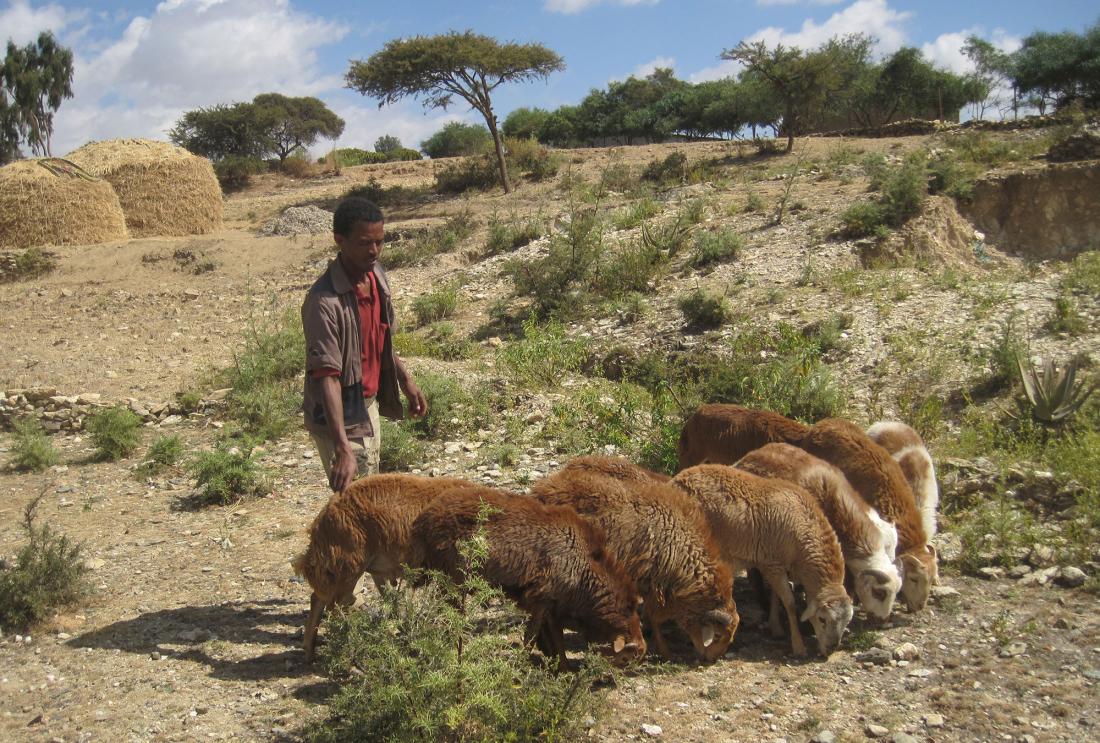
Details of the intervention
In partnership with local implementing organization Relief Society of Tigray (REST) and microfinance institution Dedebit Credit and Savings Institution (DECSI), researchers conducted a randomized evaluation to test the impact of a two-year comprehensive livelihoods program (“the Graduation approach”) on the lives of the ultra-poor. This approach was first developed by Bangladeshi NGO BRAC in 2002 and has since been replicated in several countries. From a sample of 925 households, researchers randomly assigned half to the treatment group, and half to the comparison group, which would not be eligible to receive the program.
The intervention consisted of five complementary components, each designed to address specific constraints facing ultra-poor households:
-
Productive asset transfer: One-time transfer of a productive asset valued at ETP 4,724 (2014 PPP US$1,228). Most (62 percent) of participants chose sheep and goats, while 24 percent selected oxen and 10 percent selected bees.
-
Technical skills training: Training on running a business and managing their chosen livelihood. For example, households who selected livestock were taught how to rear the livestock, including vaccinations, feed and treatment of diseases.
-
Consumption support: Regular food support is a component of the Graduation approach, but in this study it was not unique to the treatment group. The entire sample received food support (valued at a maximum 2014 PPP US$26 per month) through a separate food-for-work program.
-
Savings: Households had DECSI bank accounts opened and were required to regularly deposit savings totaling ETP 4,724 (2014 PPP US$1,228) over the two years of the program; households were unable to withdraw funds until they reached this threshold.
-
Household visits: Weekly home visits by REST staff to provide accountability, coaching, and encouragement.
The Graduation program began in 2010 and continued until May 2012. Researchers conducted a first endline survey immediately after the program ended, as well as a second endline survey around one year later.
Results and policy lessons
Across all six countries, researchers found that the program caused broad and lasting economic impacts. Treatment group households consumed more, had more assets, and increased savings. The program also increased basic entrepreneurial activities, which enabled the poor to work more evenly across the year. While psychosocial well-being improved, these noneconomic impacts sometimes faded over time. In five of the six studies, long-run benefits outweighed their up-front costs. In Ethiopia, specifically, researchers found similar effects:
Economic impacts: One year after the Graduation program ended, average total monthly consumption among treatment households was 2014 PPP US$47.50, an 18.2 percent increase over households in the comparison group. Food and durable goods spending were also higher than in the comparison group, and more households reported having enough food every day.
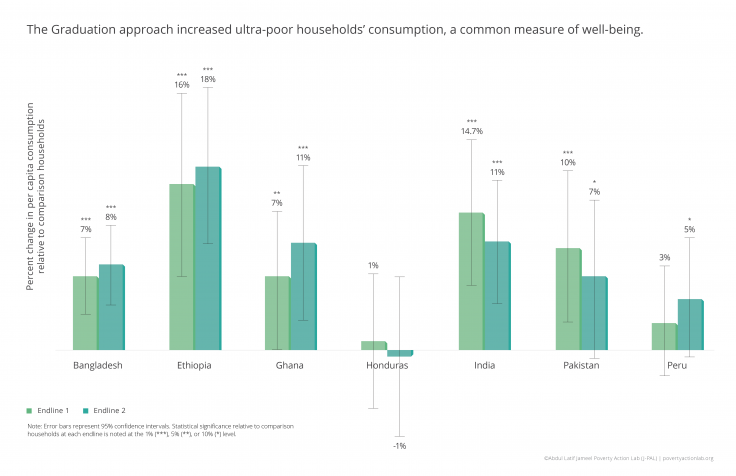
An asset analysis also revealed larger values for both productive and household assets a year after the program ended. Treatment households had 2014 PPP US$2,657 in total asset values, 68 percent more than comparison group households. For treatment group households, measures of financial inclusion also increased. Graduation program households reported borrowing and saving at higher rates than comparison group households, with a 372 percent increase in average total savings to 2014 PPP US$345.
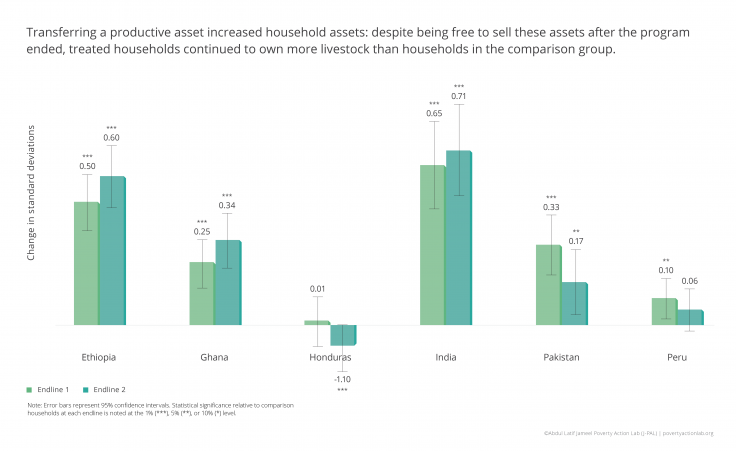
Self-employment: One year after the Graduation program ended, treatment group households reported spending 43 minutes per day on productive activities in addition to the average four hours among comparison group households. Graduation households also experienced a two-fold increase in livestock revenue relative to comparison group households.
Psychosocial wellbeing: Generally, the Graduation program did not affect measures of physical or mental health. There were no changes in illness, happiness, or stress, although treatment group households did report a smaller likelihood of feeling anxious or worried in the last year.
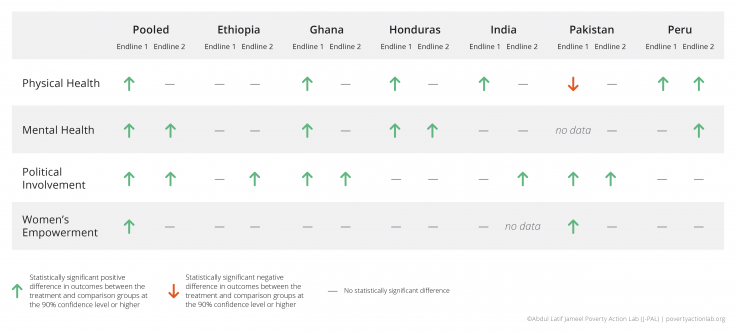
Political involvement: There is some evidence that participation in the Graduation program increased political involvement. One year after the program ended, 38 percent of treatment group households reported being a member of a political party (compared to 33 percent for the comparison group) and 57 percent attended a village meeting in the last year (compared to 52 percent for the comparison group). Participation in the Graduation program did not improve women’s decision-making power.
Cost-benefit analysis: Researchers calculated total implementation and program costs to be US$884 per household (2014 PPP US$4,157). However, estimated benefits of consumption and assets growth amount to 2014 PPP US$10,805 per household, representing an overall 260 percent return on investment.
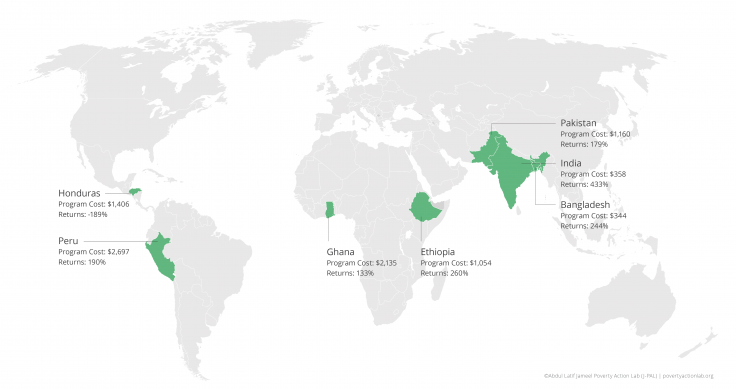
Banerjee, Abhijit, Esther Duflo, Nathanael Goldberg, Dean Karlan, Robert Osei, William Parienté, Jeremy Shapiro, Bram Thuysbaert, and Christopher Udry. 2015. “A Multi-faceted Program Causes Lasting Progress for the Very Poor: Evidence from Six Countries.” Science 348(6236), doi: 10.1126/science. 1260799.
